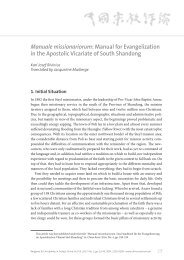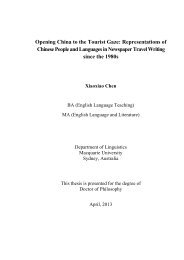EDUCATION IN CHINA
Education-in-China-a-snapshot
Education-in-China-a-snapshot
You also want an ePaper? Increase the reach of your titles
YUMPU automatically turns print PDFs into web optimized ePapers that Google loves.
Chapter 1 – Organisation and management of education in China<br />
FIGURE 1.1 CH<strong>IN</strong>A’S <strong>EDUCATION</strong> SYSTEM ORGANISATION<br />
Age<br />
Schooling<br />
27 22<br />
26 21<br />
25 20<br />
24 19<br />
23 18<br />
22 17<br />
21 16<br />
20 15<br />
19 14<br />
18 13<br />
17 12<br />
16 11<br />
15 10<br />
14 9<br />
13 8<br />
12 7<br />
11 6<br />
10 5<br />
9 4<br />
8 3<br />
7 2<br />
6 1<br />
5<br />
4<br />
3<br />
PhD programme<br />
Master’s programme<br />
University (bachelor’s degree) and vocational college<br />
Senior secondary school<br />
Junior secondary school<br />
Primary school<br />
Pre-school and kindergarten<br />
Source: OECD (2015), OECD Economic Surveys: China, OECD Publishing, Paris, http://dx.doi.org/10.1787/eco_surveys-chn-2015-en.<br />
In China, students must complete nine years of<br />
compulsory education. Most students spend six years in<br />
primary school, though a few school systems use a fiveyear<br />
cycle for primary school. Primary education starts at<br />
age six for most children. This is followed by three to four<br />
years of junior secondary education. Before the 1990s,<br />
secondary schools recruited students on the basis of an<br />
entrance examination. To emphasise the compulsory<br />
nature of junior secondary schools, and as a part of<br />
the effort to orient education away from examination<br />
performance and towards a more holistic approach to<br />
learning, the government has replaced the entrance<br />
examination with a policy of mandatory enrolment based<br />
on area of residence (Schleicher and Wang, 2014). The<br />
gross enrolment ratio for primary education in 2014 was<br />
103% compared with 104% in 2006, while for secondary<br />
education gross enrolment ratio was 94% compared with<br />
64% in 2006 (UNESCO-UIS, 2016)<br />
After finishing compulsory education, students can<br />
choose whether to continue with senior secondary<br />
education. Senior secondary education takes three<br />
years. There are five types of senior secondary<br />
schools in China: general senior secondary, technical<br />
or specialised secondary, adult secondary, vocational<br />
secondary and crafts schools. The last four are referred<br />
to as secondary vocational schools. Students undergo<br />
a public examination called Zhongkao before entering<br />
senior secondary schools, and admission depends on<br />
one’s score on this examination. The government uses<br />
examination results from Zhongkao to assign students to<br />
different senior secondary schools.<br />
China has made significant efforts to expand participation<br />
in secondary vocational schools in recent years in order to<br />
meet the country’s fast-evolving economic and manpower<br />
needs. In 2014, secondary vocational schools accounted<br />
for a little less than 22% of total senior secondary school<br />
enrolment in China (UNESCO-UIS, 2016). Although senior<br />
secondary education is not part of compulsory education<br />
in China, in 2014, 95% of junior secondary graduates<br />
continued their study in senior secondary schools<br />
(National Bureau of Statistics of China, 2015). This figure<br />
is notable because in 2005 only around 40% of junior<br />
secondary graduates attended senior secondary schools<br />
(National Bureau of Statistics of China, 2005).<br />
10 – <strong>EDUCATION</strong> <strong>IN</strong> CH<strong>IN</strong>A: A SNAPSHOT © OECD 2016





